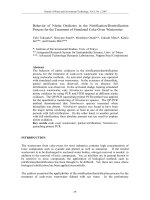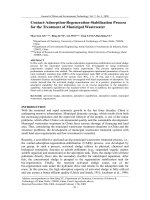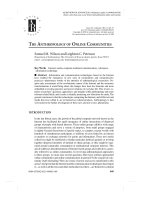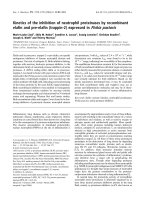- Trang chủ >>
- Khoa Học Tự Nhiên >>
- Vật lý
BACKWARD DIFFUSION PROCESS AND THE METHOD OF CONTROL OF POLLUTED ATMOSPHERE BY DUST AND INDUSTRIAL EXHAUST
Bạn đang xem bản rút gọn của tài liệu. Xem và tải ngay bản đầy đủ của tài liệu tại đây (901.2 KB, 5 trang )
Proc. Natl. Conf. Theor. Phys. 37 (2012), pp. 163-167
BACKWARD DIFFUSION PROCESS AND THE METHOD OF
CONTROL OF POLLUTED ATMOSPHERE BY DUST AND
INDUSTRIAL EXHAUST
VU BA DUNG, DINH VAN THIEN
Hanoi University of Mining and Geology
TA THI DUNG, HOANG DINH CHIEU
Ha Noi National University of Education
Abstract. The diffusion is a general process in nature. According diffusion law the diffusion
fluxes are opposite to the direction of concentration gradient (forward diffusion). However, in
some cases the backward diffusion could happen, so diffusion fluxes are in the same direction
of concentration gradient. Based on irreversible thermodynamic theory the backward diffusion is
presented and discussed, and a method of control of polluted atmosphere by dust and industrial
exhaust is suggested.
I. INTRODUCTION
Based on experimental observations and the irreversible thermodynamics theory,
diffusion processes have been described by Fick laws and Onsager laws. Both laws assumed that diffusivities are positive and diffusion fluxes are opposite to the direction of
concentration gradient (forward diffusion process). But it may be not true in some cases.
If temperature of low concentration region is higher than temperature of higher concentration region, diffusion process may be in opposite direction of forward diffusion process,
i.e. the diffusion fluxes are in the same direction of concentration gradient this diffusion is
called backward diffusion or reverse diffusion. In the backward diffusion process, molecule
concentration of the high concentration regions are increase and molecule concentration of
the low concentration regions are reduce. In other words, there is a flux molecules going
from low concentration region to high concentration region. The backward diffusion and
negative diffusivity have been studied by some authors and by us. Based on properties of
the backward diffusion, a method of control of polluted atmosphere by dust and industrial
exhaust is suggested.
II. FORWARD DIFFUSION PROCESS
Most of the diffusion process are forward diffusion. Diffusion laws (Fick law and
Onsager law) stated that diffusion currents are opposite to the direction of concentration
gradient [1,2]. The fick law is expressed by the following equation:
J = −D
∂C
∂x
(1)
164
V.B. DUNG, D.V. THIEN, T.T. DUNG, H.D. CHIEU
where C(cm3 ) is doping concentration, D(cm2 s−1 ) is diffusivity. The onsager low is given
by:
∂µ
J = −L
(2)
∂x
where µ is chemical potential, L is Onsager coefficient. L and D are related as
follows:
DC
(3)
kT
where k is Boltzmann constant, T is absolute temperature. However, thermodynamics
prove that equations of Fick law (1) and Onsager law (2) are true solution only in low
chemical potential condition. In general, Fick and Onsager lows are nonlinear:
L=
µ − µ0 ∂µ
D
exp
(4)
kT
kT ∂x
where µ0 is constant. Fick and Osager diffusion laws indicate the diffusivities are
always positive. The diffusion flows in the direction of decreasing concentration.
J =−
III. NEGATIVE DIFFUSIVITY AND BACKWARD DIFFUSION
PROCESS
When the diffusion flows in the direction of increasing concentration, the diffusion is
called backward. Backward diffusion occurs when diffusivity is negative. There are some
calculations and experiments showed that backward and negative diffusivity could happen.
In the simultaneous diffusion of boron, silicon-self interstitial and vacancy in silicon, the
silicon-self interstitial diffusion is described by the following equation [5-9]:
1
DI CI − DB CB ∂CI
JI = − (2DI + DV +
)
−
2
CV
∂x
D V CV − D I CI
DI CI − DB CB ∂CB
1
+
)
(5)
− (DV − DB +
2
CB
CV
∂x
The previous studies show that the effective diffusivity Def f of silicon-self interstitial
could be positive or zero, or negative. The fig.1 is the graph of the effective diffusivity
of silicon-self interstitial dependent on diffusion depth, that show that Def f is negative
near silicon surface. So the diffusion process of silicon-self interstitial is backward, i.e. the
diffusion flux of silicon-self interstitial is from the region of low concentration to the region
of high concentration [5-9] :
1
D I CI − D B CB
Def f = − (2DI + DV +
)
(6)
2
CV
Some experiment results on diffusion in silicon have showed the backward diffusion
of point defects. The anomal diffusion phenomena in silicon may be related to backward
diffusion like Lateral Diffusion Effect, Stacking Faults (SF) and ring Stacking Faults (ringSF) [10].
Fig.2 is the ring Stacking Faults in silicon, that is studied by H.Yoshida etal[9].
BACKARD DIFFUSION PROCESS AND THE METHOD OF CONTROL...
165
Fig. 1. The effective diffusivity of interstitial in silicon
Fig. 2. The ring Stacking Faults in silicon [9].
IV. FORWARD DIFFUSION AND BACKWARD DIFFUSION EQUATION
The negative diffusivity and backward diffusion process are explained by thermodynamics theory of transport processes.
Consider the two equal thickness slices of a solid illustrated in fig.3, where slice I and
slice II have different impurities concentration (C1 < C2 ). Thermal agitation velocities of
molecules in slice I and slice II are not identical (u1 > u2 ). We denote :
u1 = u; u2 = u + V
(7)
C1 = C; C2 = C + ∆C
(8)
The molecule flux from slice I to slice II is:
166
V.B. DUNG, D.V. THIEN, T.T. DUNG, H.D. CHIEU
Fig. 3. The diffusion modeling
u1 C1
uC
=
6
6
(9)
u2 C2
uC + V C + u∆C − V ∆C
=
6
6
(10)
J1 =
and flux from slice II to slice I is :
J2 =
The flux diffusion is :
u−V
V
)∆C − C
6
6
For macroscopic description, we can use an approximate :
J = J1 − J2 = −(
(11)
∂C
(12)
∂x
Using approximate (12) from equation (11) the flux diffusion is determined by :
∆C ≈ λ
u − V ∂C
)
−VC
6
∂x
Applying Fick law from equation (13) we have general diffusion equation :
J = −(
(13)
∂C
∂2C
∂C
= Ddif
+ udri
(14)
2
∂t
∂x
∂x
Equation (14) is transmission-diffusion parabolic form, where Ddif and udri are
called diffusivity and drift term and given by:
u−V
V
; udri =
(15)
6
6
The equation (14) and (15) show that :
i) If V < u the diffusivity Ddif is positive and the diffusion process is forward.
ii) If V = u the diffusivity Ddif is vanished and there is not diffusion process.
iii) If V > u the diffusivity Ddif is negative and the diffusion process is backward.
Backward diffusion and forward diffusion are described by the same equation form,
but the sign of diffusivity is different.
Ddif =
BACKARD DIFFUSION PROCESS AND THE METHOD OF CONTROL...
167
V. POSSIBLE APPLICATION IN POLLUTED EARTH’S ATMOSPHERE
CONTROL
Main mechanism of air pollution in earth’s atmosphere is the forward diffusion.
The dust and industrial exhaust are generated on earth’s surface get up in the sky, so
the dust and industrial exhaust concentration increases in earth’s atmosphere. Based on
the interesting properties of the backward diffusion, we propose a method of control of
polluted atmosphere, that is called ”backward diffusion method”. In this method, the
conditions for backward diffusion of dust and industrial exhaust are made somehow by
human. Then in the backward diffusion, dust and industrial exhaust transport from the
atmosphere back to earth’s surface.
VI. CONCLUSION
When the thermal agitation velocity of molecules in the low concentration region is
faster than in the high concentration region, the diffusivity could be negative and diffusion
process could be backward. In the backward diffusion, the diffusion flux is from the region
of lower concentration to the region of higher concentration. The backward diffusion
process could be occurred in simultaneous of boron, silicon-self interstitial and vacancy
in silicon. The backward diffusion could be applied as a new method for the control of
polluted earth atmosphere by dust and industrial exhaust.
REFERENCES
[1]
[2]
[3]
[4]
[5]
[6]
[7]
[8]
[9]
[10]
[11]
[12]
[13]
[14]
[15]
[16]
[17]
[18]
A.Fick, Phil. Mag 10(1855)30.
,J. Philibert Diffusion fundamentals 2 (2006) 1-10.
,G.D.C.Kuiken, Thermodynamics of Irreversible Processes, Wiley, London (1994).
P.Garbaczewski, Acta. Phys. Pol. E39 (2008) 1087-1101.
V.B.Dung, D.K. An and N.N.Long, Proceedings of the 1st Academic Conference on Natural Science
for Master Electronics, Pergamum Press 13 (1970) 165-172.
V.B.Dung and Dao Khac An, Defect and Diffusion Forum 94 (2001) 6470-652.
V.B.Dung and D.K.An,P.A.Tuan and N.N.Long, Proceedings of The Osaka University-Asia PacificVietnam National University Forum (2005) 92.
V.B.Dung, D.K.An and P.A.Tuan and N.V. Truong, Defect and Diffusion Forum 258 (2007) 32-38.
H.Yoshida, M.Ohmori (1992), Applied Physics Letters, 60, p. 2389.
G.Gilboa, N. Sochen and Y.Zeevi, IEEE Transaction in Image Processing 11(2002) 698-703.
A.Visintin, Calculus of Variations and PDE 15 (2002) 115-132.
,L.C.Evans, American Math Society, third printing (2002).
L.C.Evans and M. Portilheiro, Math. Models Method Appl. Sci.14 (2009) 341-351.
B.H.Gilding and A.Tesei, Phys. D. 239 (2010) 291-311.
, A.Terracina and A.Tesei,Arch.National Mech. Anal. 194 (2009) 887-925.
D. Pelinovsky and M.Chugunova, J.math.Appl. 243 (2008) 970-988.
M.Slemrod, J.Dyn. Differential Equations 3 (1991) 614-622.
L.C.Evans and M.Portilheiro, Math. Models Method Appl. Sci.14 (2009) 341-351.
Received 30-09-2012.









